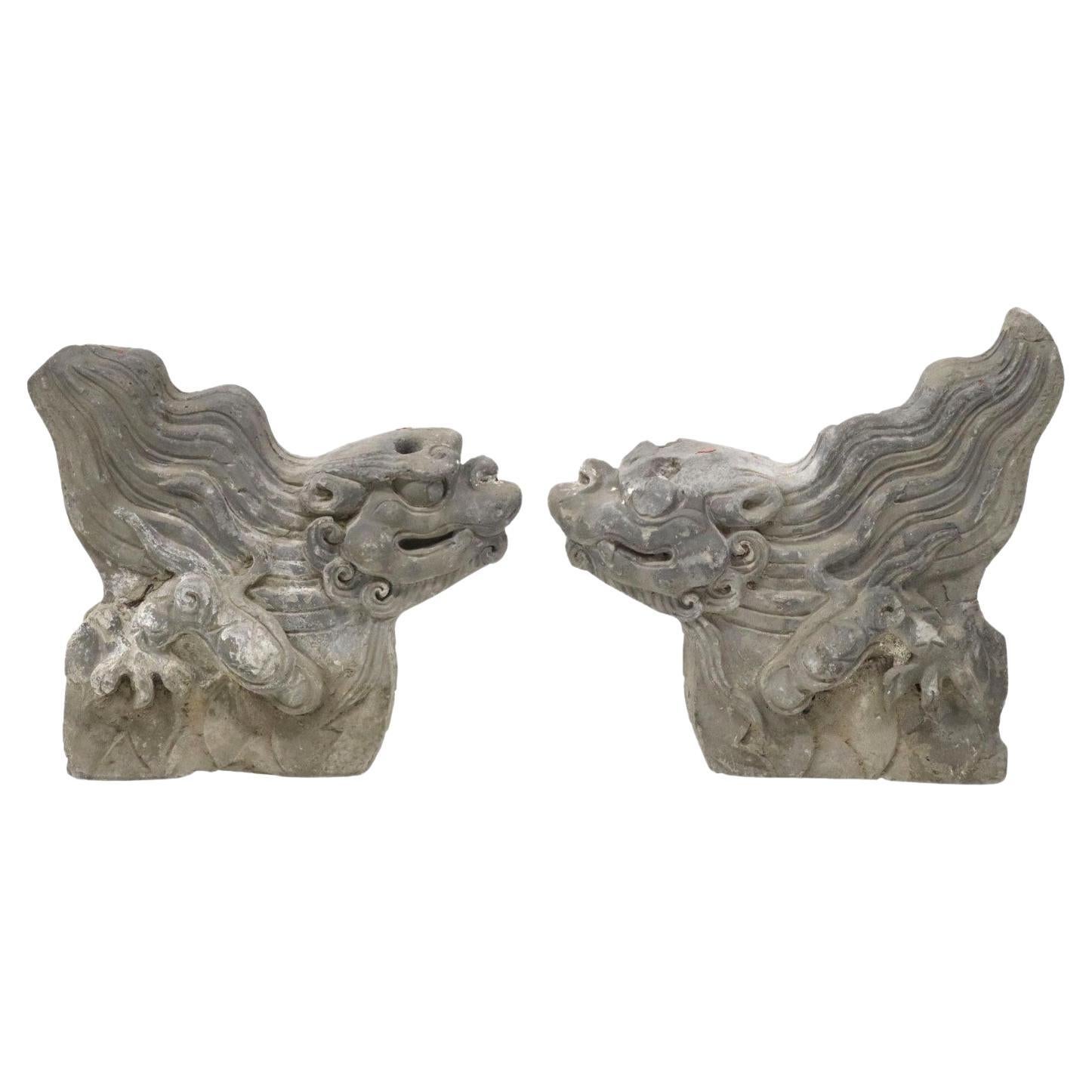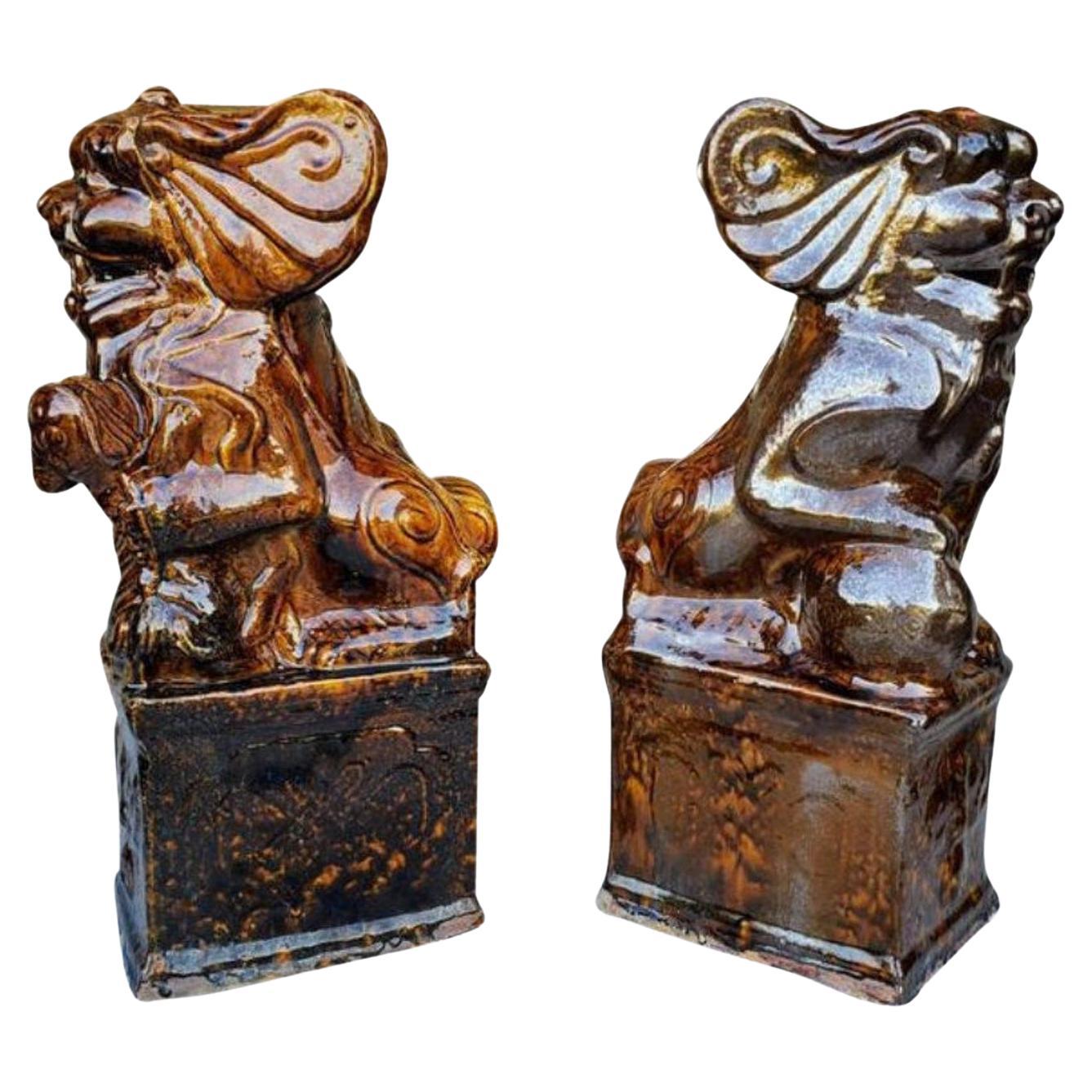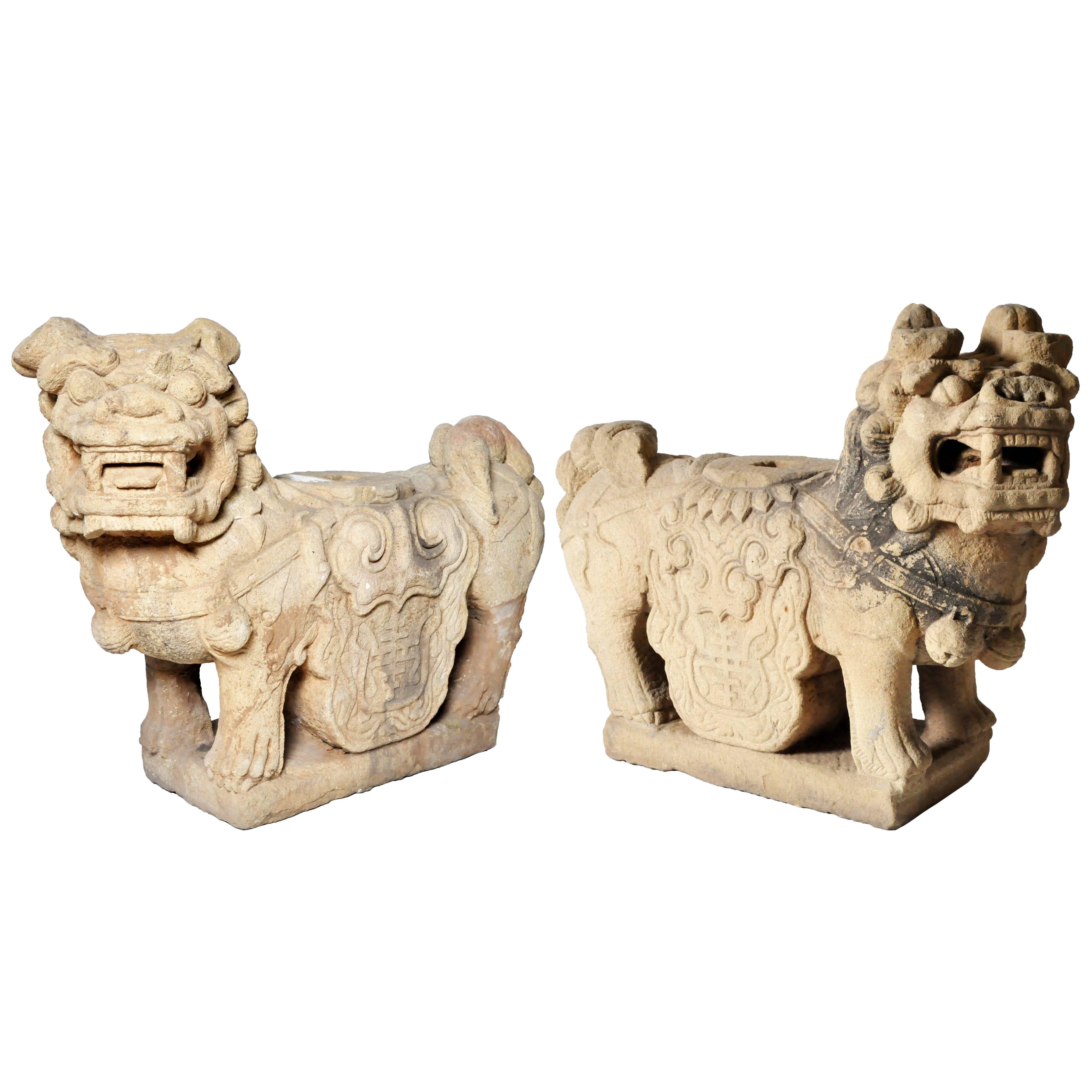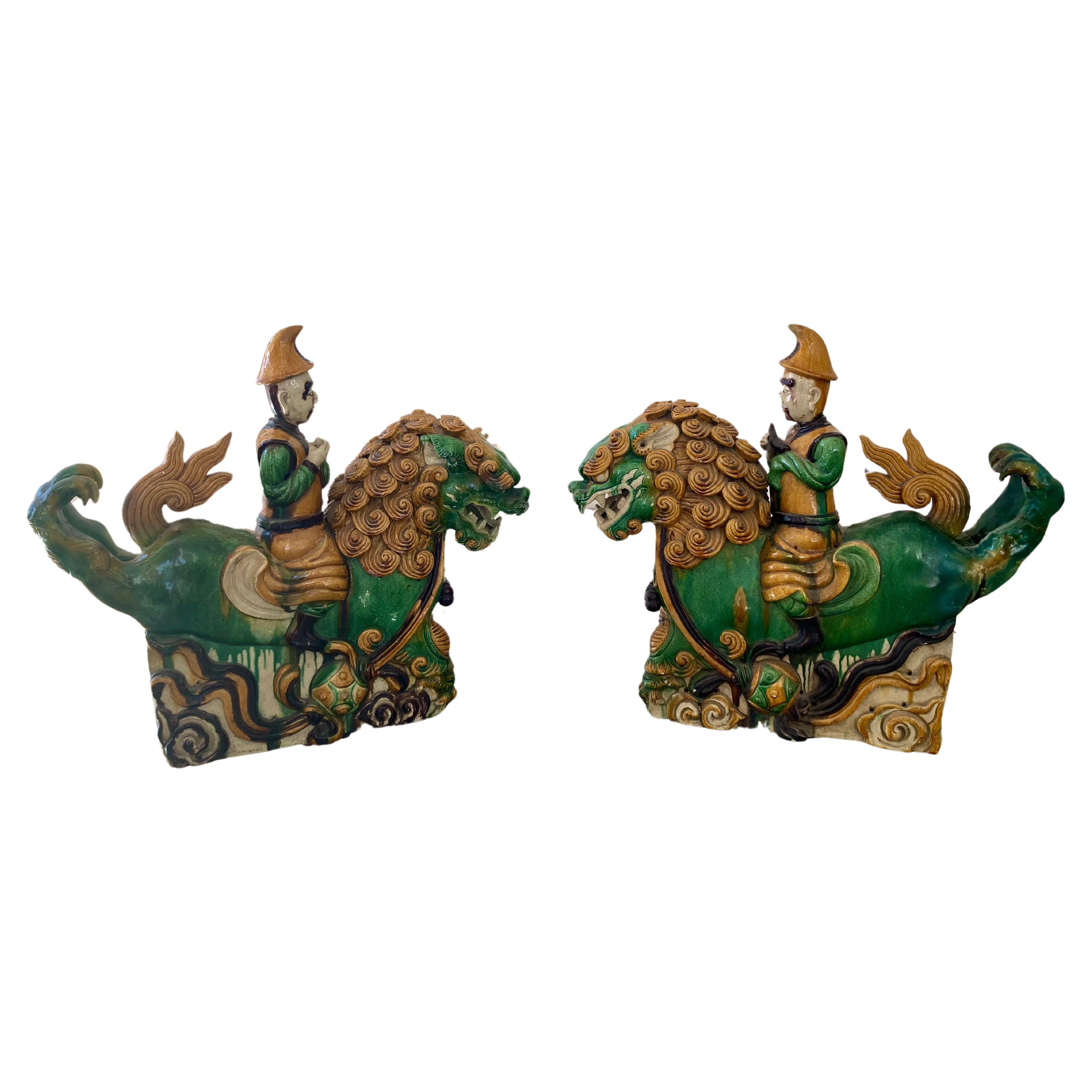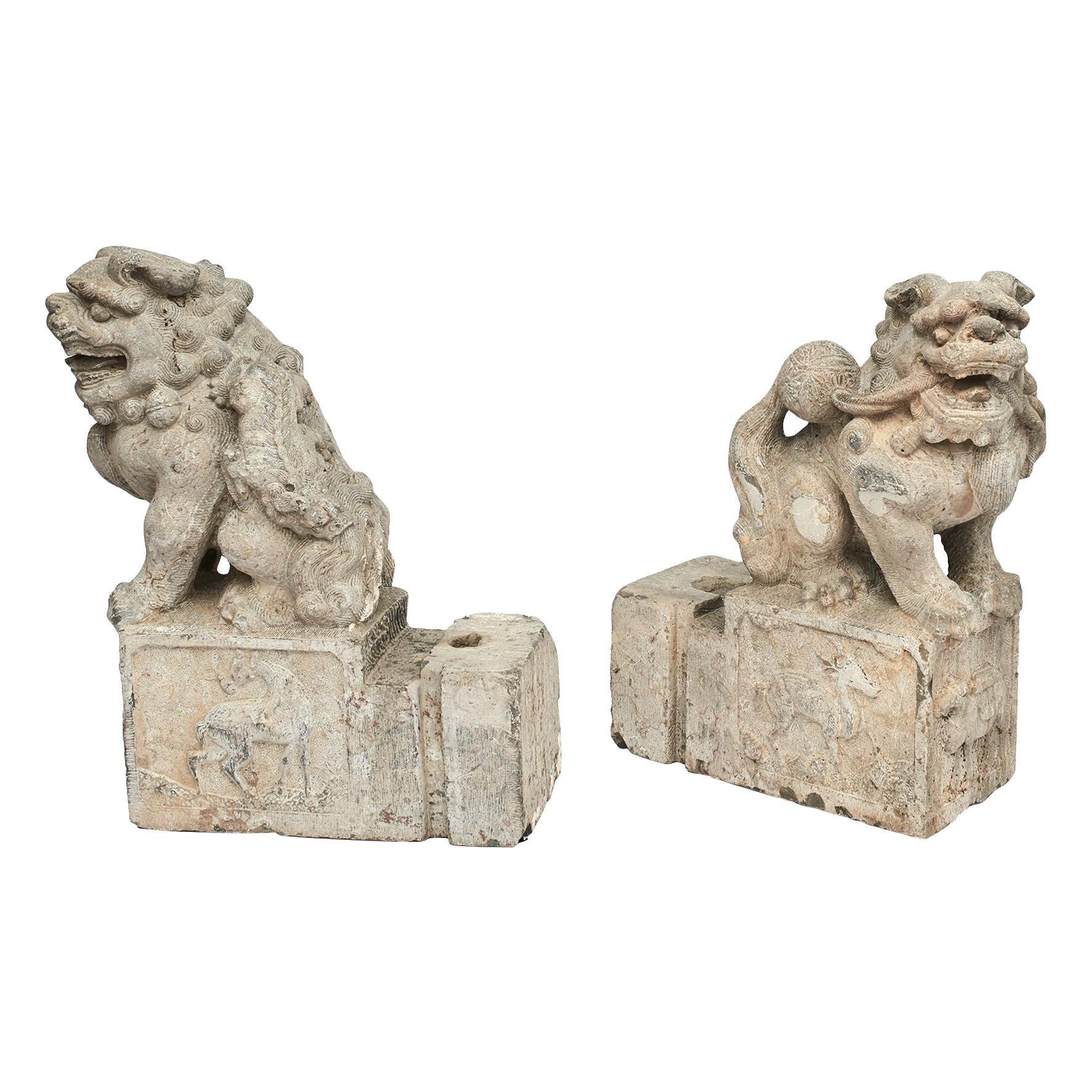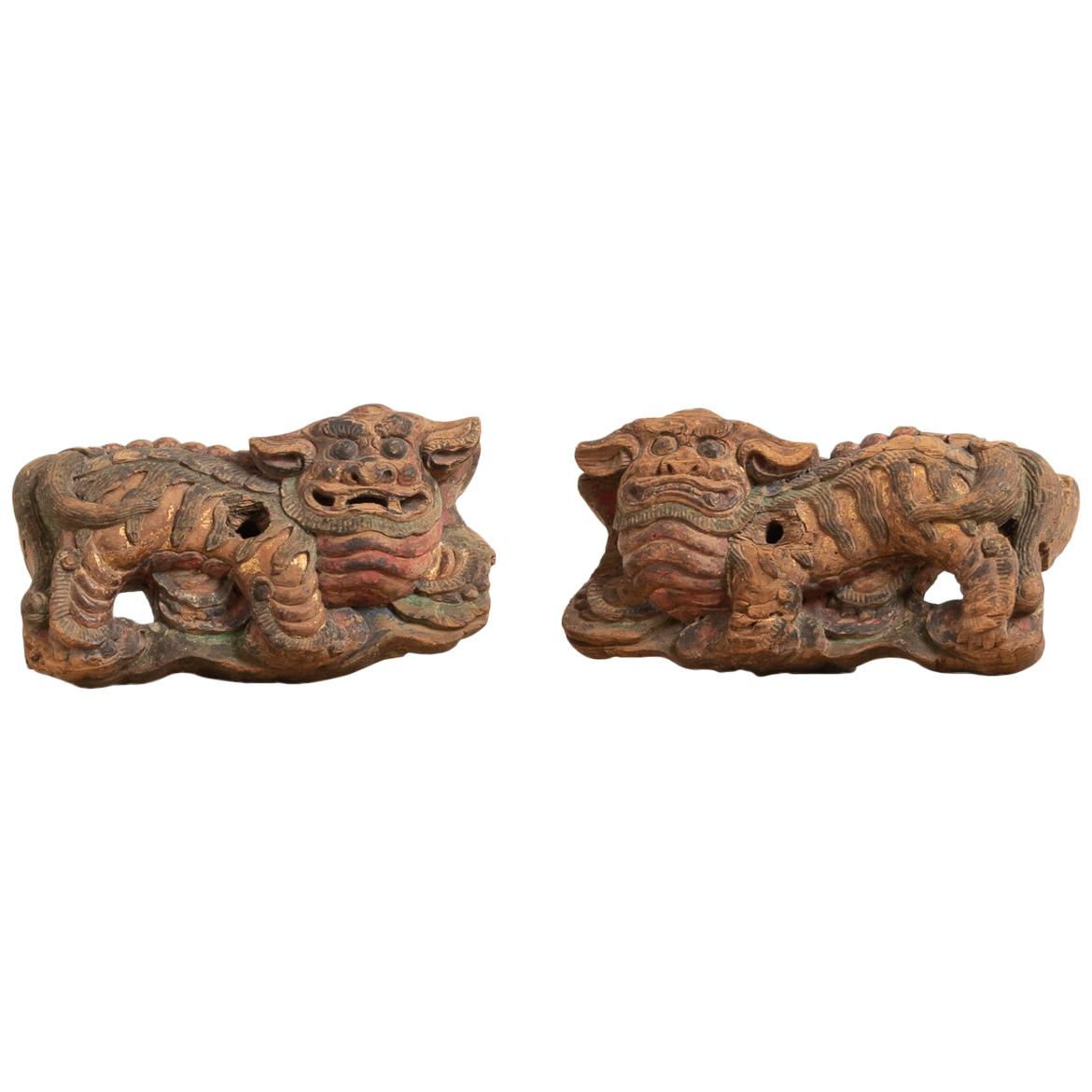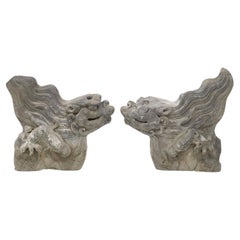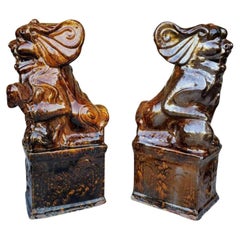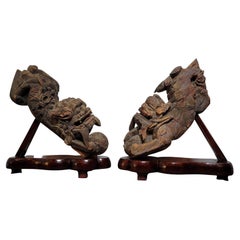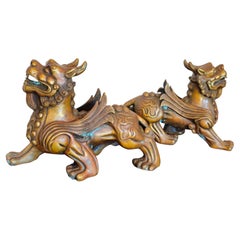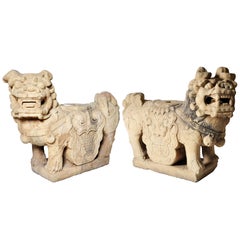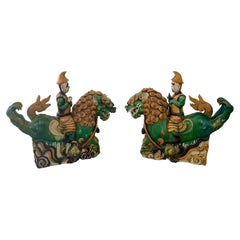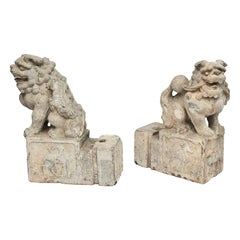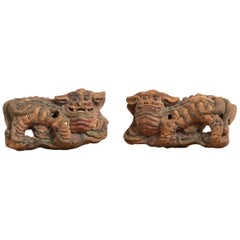Items Similar to Antique Qing Dynasty Chinese Glazed Terracotta Guardian Lion Roof Tile Figures
Want more images or videos?
Request additional images or videos from the seller
1 of 21
Antique Qing Dynasty Chinese Glazed Terracotta Guardian Lion Roof Tile Figures
$11,250per set
£8,502.83per set
€9,799.83per set
CA$15,873.76per set
A$17,493.98per set
CHF 9,158.68per set
MX$214,881.37per set
NOK 115,080.80per set
SEK 107,706.47per set
DKK 73,169.59per set
About the Item
A remarkable pair of rare antique Qing Dynasty (1636-1912) Chinese terracota architectural roof tile beasts. circa 1900
Hand-crafted in Imperial China around the turn of the late 19th / early 20th century or possibly earlier, most likely the Forbidden City in Northern China, figural form depicting Guardian Lion / Foo Dog, in a deep rich dark green glaze, pewter silver-tone and heavily weathered patina, highly detailed, each depicted forward facing, front feet standing on ball, roaring with teeth exposed and mouth ajar. One retaining remnant/partial red wax export seal indicating they were legally exported out of the country.
Presumably these highly decorative end tiles would have originally adorned the roof of an important Chinese temple or palace. Today, they make for outstanding Asian sculptures!
The near matching architectural salvage ornaments present superbly with beautifully aged weathered patina, rich deep warmth and luminous sheen. Expected wear and buildup consistent with age, use, and exposure.
Dimensions each (approx):
Each: 15.25" high, 5.75" wide, 10.5" deep.
History:
Chinese roof tiles have been a part of Chinese architecture for over 2,000 years. These unique and beautifully crafted tiles have become an integral part of traditional Chinese culture, and have gained international recognition for their beauty and cultural significance. In this article, we will explore the different types of Chinese roof tiles, their construction, cultural significance, preservation and restoration techniques, and modern uses.
Chinese imperial roof decorations or roof charms or roof-figures (Chinese: 檐獸/檐兽; pinyin: yán shòu) or "walking beasts" (Chinese: 走獸/走兽; pinyin: zǒu shòu) or "crouching beasts" (Chinese: 蹲獸/蹲兽; pinyin: Dūn shòu) were statutes placed along the ridge line of official buildings of the Chinese empire. Only official buildings (palaces, government buildings, and some temples) were permitted to use such roof decorations.
Occasionally arranged in an outward marching procession with various different examples, the number and type indicating the importance of the duties performed within the building or within the courtyard protected by a gate. With a maximum number of nine, the mythical beast was one of the highest in rank, thus modeled set to pounce upon the man and lower ranking creatures, ready to devour them should they stray from performing their duties with faithfulness and rectitude
The Design and Construction of Chinese Roofs:
The roof design is an important aspect of Chinese architecture, with each component of the roof playing a specific role. Chinese roof tiles fit into the overall design of the roof and are placed on top of wooden supports called purlins. The interlocking system of Chinese roof tiles ensures that they stay in place and prevent leaks. Ridge tiles are used to join the two slopes of the roof and add a decorative touch to the roofline. Other decorative elements include animal statues, which are placed at the corners of the roof. Chinese roofs are typically of the hip roof type, with small gables, so decorations along the ridge line were highly visible to observers. Variant versions are still widespread in Chinese temples and has spread to the rest of East Asia and parts of Southeast Asia.
The Cultural Significance of Chinese Roof Tiles:
Chinese roof tiles have a rich cultural history and are deeply symbolic in traditional Chinese culture. They represent prosperity, good fortune, and protection from evil spirits. The color red is associated with good luck, while green represents harmony and balance. Chinese roof tiles also reflect traditional Chinese values, such as harmony with nature and respect for the past. These values are still an important part of modern Chinese culture.
- Dimensions:Height: 15.25 in (38.74 cm)Width: 5.75 in (14.61 cm)Depth: 10.5 in (26.67 cm)
- Sold As:Set of 2
- Style:Qing (Of the Period)
- Materials and Techniques:
- Place of Origin:
- Period:
- Date of Manufacture:circa 1900
- Condition:Wear consistent with age and use. The near matching architectural ornaments present superbly with beautifully aged weathered patina, rich deep warmth and luminous sheen. Expected wear and buildup consistent with age, use, and exposure.
- Seller Location:Forney, TX
- Reference Number:1stDibs: LU5977226927932
About the Seller
4.8
Platinum Seller
Premium sellers with a 4.7+ rating and 24-hour response times
Established in 2013
1stDibs seller since 2021
296 sales on 1stDibs
Typical response time: <1 hour
- ShippingRetrieving quote...Shipping from: Forney, TX
- Return Policy
Authenticity Guarantee
In the unlikely event there’s an issue with an item’s authenticity, contact us within 1 year for a full refund. DetailsMoney-Back Guarantee
If your item is not as described, is damaged in transit, or does not arrive, contact us within 7 days for a full refund. Details24-Hour Cancellation
You have a 24-hour grace period in which to reconsider your purchase, with no questions asked.Vetted Professional Sellers
Our world-class sellers must adhere to strict standards for service and quality, maintaining the integrity of our listings.Price-Match Guarantee
If you find that a seller listed the same item for a lower price elsewhere, we’ll match it.Trusted Global Delivery
Our best-in-class carrier network provides specialized shipping options worldwide, including custom delivery.More From This Seller
View AllChinese Ming Dynasty Architectural Terracotta Roof Tile Figure Qilin Foo Dog pr
Located in Forney, TX
A remarkable pair of large Ming Dynasty (1368-1644) earthenware Imperial roof decorations - ornamental architectural terracotta roof tile beasts.
15th/16th century or earlier, Northern China, most likely Forbidden City, Dongcheng District, Beijing, figural pottery modeled as mythical qilin (foo dog / guardian lion), the crouching beast with legs back and flaming body depicted ready to pounce. Retaining partial remnants of the red wax export seal, indicating they are authentic and were legally exported out of the country.
Dimensions: (approx)
Largest: 18" Tall, 19" Wide, 8" Deep
History:
Chinese roof tiles have been a part of Chinese architecture for over 2,000 years. These unique and beautifully crafted tiles have become an integral part of traditional Chinese culture, and have gained international recognition for their beauty and cultural significance. In this article, we will explore the different types of Chinese roof tiles, their construction, cultural significance, preservation and restoration techniques, and modern uses.
Chinese imperial roof decorations or roof charms or roof-figures (Chinese: 檐獸/檐兽; pinyin: yán shòu) or "walking beasts" (Chinese: 走獸/走兽; pinyin: zǒu shòu) or "crouching beasts" (Chinese: 蹲獸/蹲兽; pinyin: Dūn shòu) were statutes placed along the ridge line of official buildings of the Chinese empire. Only official buildings (palaces, government buildings, and some temples) were permitted to use such roof decorations.
Occasionally arranged in an outward marching procession with various different examples, the number and type indicating the importance of the duties performed within the building or within the courtyard protected by a gate. With a maximum number of nine, the mythical beast was one of the highest in rank, thus modeled set to pounce upon the man and lower ranking creatures, ready to devour them should they stray from performing their duties with faithfulness and rectitude
The Design and Construction of Chinese Roofs:
The roof design is an important aspect of Chinese architecture, with each component of the roof playing a specific role. Chinese roof tiles fit into the overall design of the roof and are placed on top of wooden supports called purlins. The interlocking system of Chinese roof tiles ensures that they stay in place and prevent leaks. Ridge tiles...
Category
Antique 16th Century Chinese Ming Sculptures and Carvings
Materials
Earthenware, Terracotta
Antique Chinese Glazed Guardian Lion Foo Dogs, a Pair
Located in Forney, TX
A magnificent pair of large antique Chinese porcelain temple Guardian Lions - Foo Dogs. The near matching male and female pair of handcrafted arc...
Category
Antique 19th Century Chinese Chinese Export Statues
Materials
Porcelain
Antique Asian Carved Foo Dog Lion Architectural Corbels, a Pair
Located in Forney, TX
A magnificent pair of Qing Dynasty (1644-1912) antique Chinese architectural elements with beautifully aged patina. circa 1900
Most impressive large scale, likely sculptural corbels from a Buddhist temple or imperial palace, late 19th / early 20th century, each intricately hand carved with very fine detailing, similarly styled pair, modeled as guardian foo lion, depicted with outstretched arched body, mouth ajar, clutching floral ball, having elaborate openwork carvings, with scattered remnants of original polychrome paint remaining.
The highly decorative architectural salvaged ornamental building elements presented on custom made hand carved wooden sculpture stands...
Category
Early 20th Century Chinese Qing Architectural Elements
Materials
Wood, Paint
Pair of Chinese Bronze Pixiu Winged Lion Figure Feng Shui Mythical Beast Statue
Located in Forney, TX
A stunning pair of excellent quality bronze Pixiu wealth dragon mythical creatures with visually striking scattered verdigris bluish green patina!
Well known in Chinese culture and...
Category
Early 20th Century Chinese Qing Sculptures and Carvings
Materials
Bronze
Qing Dynasty Chinese Carved Green Jade Chilong Dragon Sculpture
Located in Forney, TX
A magnificent Chinese carved spinach green jade chilong dragon sculpture, resting on fitted hardwood stand.
Rich deep bright green color with molten shades of lighter pale green, exceptionally carved, with intricate detail throughout. The mythical beast lying ready on all four, head raised, mouth ajar with teeth exposed, wings by its side, spiral scroll incised on hind legs.
Provenance:
Estate of Ali A. Abssi (1934-2020) and Florence Hall Abssi (1919-2014), founders of the Ishtar Gate...
Category
Antique 19th Century Sculptures and Carvings
Materials
Jade
Pair of Qing Dynasty Chinese Religious Temple Architectural Ornament
Located in Forney, TX
A scarce pair of Qing Dynasty temple architectural ornaments, the decorative antique building element fragments each elaborately hand carved, polychrome painted and lacquered, richly detailed featuring two figural pairs accented...
Category
Antique Early 19th Century Asian Folk Art Architectural Elements
Materials
Mother-of-Pearl, Wood, Lacquer, Paint
You May Also Like
Pair of Chinese Stone Guardian Lions
Located in Chicago, IL
Often referred to as “Fu Dogs” in western culture, these handsome stone sentinels are iconic gatekeepers seen throughout China and elsewhere in Asia. Traditional symbols of protectio...
Category
Antique 19th Century Chinese Sculptures and Carvings
Materials
Limestone
$16,900 Sale Price / set
35% Off
Chinese Glazed Terra Cotta Foo Dog Roof Tiles, a Pair
Located in Los Angeles, CA
Beautiful pair of Chinese glazed terra cotta foo fogs roof tiles. Amazing sculpting details and colors.
Category
Antique Late 19th Century Chinese Other Sculptures and Carvings
Materials
Terracotta
Antique Pair of Late Ming Dynasty Silk Road Carved Stone Guardian Lions
Located in Kastrup, DK
Rare pair of large Chinese carved stone foo dog guardian lions. Originated from a house of a mandarin (a public official in the Chinese Empire), located on The Silk Road.
Here they were placed in front of the gate, with the gate doors mounted on the base behind the lions.
The pair consist of a male with a ball on his back, and a female holding a puppy. The ball represents the world and the puppy represents nature or a nurturing spirit.
One stand lightly carved with a horse, the other with a deer. The front of the stand is carved with camel...
Category
Antique 17th Century Chinese Ming Statues
Materials
Stone
19th Century Chinese Guardian Lions in Original Condition
Located in Kramfors, SE
Chinese guardian lions in original condition. The lions are made from wood and were handmade sometime during the 19th century in China. The guard...
Category
Antique 19th Century Chinese Chinese Export Sculptures and Carvings
Materials
Wood
Antique Fengshui Chinese Bronze Guardian Lion Foo Dog Statue Sculpture - Pair
Located in Chicago, IL
Antique Fengshui Chinese Bronze Guardian Lion Foo Dog Statue Sculpture - Pair
Chinese guardian lions, also called Fu (Foo) Lions, lions of Buddha, are a common representation of th...
Category
Early 20th Century Unknown Chinese Export Sculptures and Carvings
Materials
Bronze
20th Century Antique Chinese Qing Era Porcelain Foo Dogs
Located in Pomona, CA
This pair of magnificent Chinese antique Porcelain lions/foo dogs statuary are hand made and hand carved porcelain. According to historical ...
Category
Early 20th Century Chinese Chinese Export Ceramics
Materials
Porcelain
$19,250 Sale Price
44% Off
